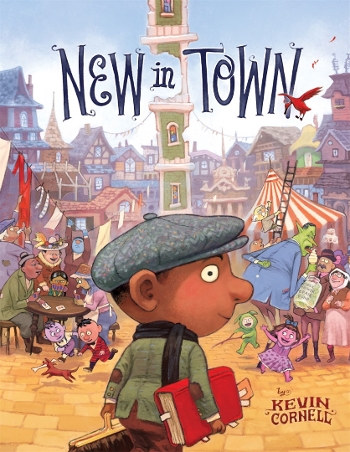Kevin Cornell's New in Town is a story whose subtext is told entirely via the illustrations. The pictures don’t serve an auxiliary role; they reveal the antagonist's true motivations, often even subverting the words we read. It is in the visual narrative — and in all its pleasing details — that the truth is told.
 As we here at Calling Caldecott ponder which books the Real Committee might be affording their time and attention, I wonder about Kevin Cornell’s New in Town. It spins a visually rich and satisfying David-versus-Goliath type of tale, one that pits a larger-than-life con man against a humble newcomer.
As we here at Calling Caldecott ponder which books the Real Committee might be affording their time and attention, I wonder about Kevin Cornell’s New in Town. It spins a visually rich and satisfying David-versus-Goliath type of tale, one that pits a larger-than-life con man against a humble newcomer.
The town of Puddletrunk is a tall and precarious one. It is (dramatically and comically) composed of crude wooden structures stacked high atop one another, a wobbly clock tower at the center, all crowded on a tiny piece of land that juts up from the ground and stands in an abyss. (This element of the book’s setting is but one part of the story’s humor: it’s as if the town suffered an earthquake at some point but didn’t bother to consider moving from the minuscule piece of land left standing in the chasm.) Needless to say, the town desperately needs a bridge to connect it to the nearby mainland, but the bridges keep collapsing. Over and over again. We see the current bridge fall to pieces before the story's text appears: Cornell fills the book’s front matter with kinetic images of snapping ropes and tumbling wood. And in the first full-page spread alone, because Cornell packs these pages with detail, we learn that there’s been a long history of crumpling bridges (more than 200); that the “local bridge troll” and “termite expert” Mr. Mortimer Gulch has offered to fix them; and that termites are blamed.
After each bridge collapses, the Grinch-like Mr. Gulch (tall, green, and sporting a tiny bowler hat) takes donations from the townspeople — jewelry and cash will do, thanks very much. Meanwhile, the clock tower remains broken, and there’s no money to fix it. Cue our titular hero, the small and smartly dressed boy you see on the cover. He says he’ll fix the clock tower for free. As the story progresses, we learn that Mr. Gulch himself (who, come to think of it, resembles an oversized green termite) has been sabotaging the town by chewing on the bridges and forcing each collapse. His treachery is revealed when the traveling clock repairman refuses to donate any of his wood for the construction of the new bridge, and irate Mr. Gulch snacks on the base of the clock tower: “Towers, in fact, were just as delicious as bridges!”
This is a story whose subtext is told entirely via the illustrations. The pictures don’t serve an auxiliary role; they reveal the antagonist's true motivations, often even subverting the words we read. Mr. Gulch is a swindler who sells the townspeople on the folly that he’s a savvy and successful bridge-builder and businessman, yet it’s all fiction. In effect, he robs them of their money, as the illustrations alone tell us. Remember how Uri Shulevitz describes this in Writing with Pictures: “A picture book says in words only what pictures cannot show. ... It could not, for example, be read over the radio and be understood fully.” Read this one without seeing the illustrations, and you’d be utterly lost. It is in the visual narrative — and in all its pleasing details — that the truth is told. For instance, when we read that Mr. Gulch is an “awe-inspiring orator” and a “master of motivation rhetoric,” the illustrations reveal much more: the townspeople look frightened (some, tired), and next to Mr. Gulch is a book on the ground called The Art of Yelling. On another spread, we see a book called Bullying for Profit. And when we see him flee the town on “urgent business,” we read “What a good sport!” In reality, he’s taken the town’s money, leaving in his wake a hot dog (one of many he dines on throughout the story) stuffed into the same jar he had used for collecting donations. The book is rife with such visual jokes and is one for reading slowly — and rereading. The best tiny detail of all for observant readers may be, as Martha noted in her review of this one, that the clock tower repairman's blueprint (look closely at his desk) reveals that he is on to Mr. Gulch and has all along been executing a plan for a new bridge (the smart plan that comes to pass).
There’s a lot more to appreciate here: Cornell’s impressive world-building (I’d gladly read more stories about Puddletrunk, a town so vividly constructed); the book’s curling once-upon-a-time kind of font, which looks like hand-lettering (and could very well be?); the immersive full-bleed spreads that invite you into this world; and the dramatic, cinematic lighting.
I also love Cornell’s repeated mentions of how the clock tower repairman was “new in town” and “did not know how things worked.” After all, sometimes we need a fresh perspective on things to make true progress and break entrenched, destructive habits. I wonder if the Real Committee will pore over this story, taking a close look (much like this book’s small hero does) at how it all works.

RELATED
ALREADY A SUBSCRIBER? LOG IN
We are currently offering this content for free. Sign up now to activate your personal profile, where you can save articles for future viewing.







Add Comment :-
Be the first reader to comment.
Comment Policy:
Comment should not be empty !!!